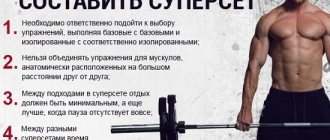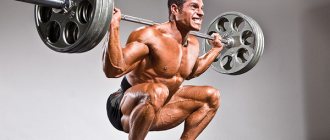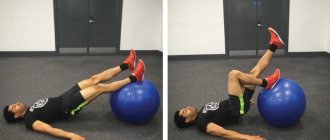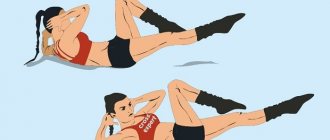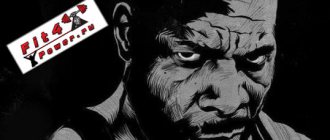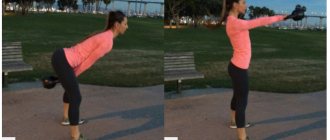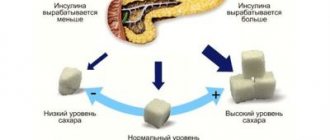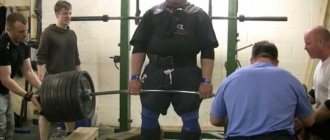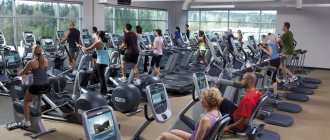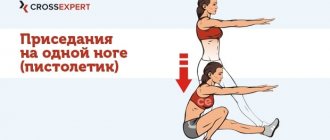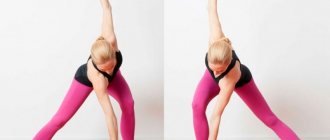The half squat is a strength exercise that strengthens ligaments and works the upper phase of the squat range of motion. You shouldn’t just do a half squat, but you also don’t need to give it up completely. Many athletes disdain this exercise, although they are happy to perform partial range of motion presses. Squats above parallel are an effective technique for tricking the Golgi tendon organ, helping to “acclimate” the muscles to heavier weights. Another thing is that this is just one of the methods of leg training, which must be used in combination with other exercises, but partial amplitude has its place and it gives a positive result.
The half squat should not be performed by beginners, although many athletes begin squatting with this exercise, being afraid to sit down deeply. There is no need to do this! You can use partial amplitude in squats to strengthen ligaments, tendons, and increase strength, but at the same time, be sure to use basic squats with a barbell . While bulking, the half squat can, of course, be a way to create unusual stress on the muscles, but such techniques should be used by athletes who are already training intuitively, understanding and feeling their body's response to training. This exercise can be included in the training program on an ongoing basis when the athlete is training for strength .
Features of the half squat
The barbell half squat is used primarily in weightlifting and powerlifting, where the movement is competitive (or part of a compound movement such as the clean and jerk). In bodybuilding and fitness, the half squat can only be used when the athlete is experiencing problems in subsequent growth of strength indicators, has reached a plateau and is not progressing further.
Unlike the classic (up to the parallel of the thigh with the floor) and deep half-squats, partial amplitude is more dangerous. The main load falls on the knees, so the partial squat technique is used for a short period of time. The main task is to prepare ligaments, stabilizer muscles and tendons to increase working weights using conventional techniques.
Full amplitude squats are not used as a permanent movement, since the technique is inferior to other variations in both safety and effectiveness.
What does deep, parallel and partial squats have to do with it?
It's simple: if you performed a test wall squat with full amplitude, then the classic deep squat is your exercise. If failure befell you at the moment when your hips took a parallel position (or close to it), then squats to parallel are anatomically more suitable for you. And finally, if you were unable to perform the test squat, and the problem arose in the initial phase of the amplitude, then stop at the partial amplitude.
With all this, it is important to know the following: failures when performing a deep wall squat test are associated with several reasons.
Benefits and disadvantages
The main benefits of half squats:
- Preparing the muscle corset, ligamentous apparatus and even the endocrine system for increasing working weights.
- Training the upper phase of the squat, which often lags behind in athletes (especially those who use momentum when lowering).
- Powerful load on the quadriceps.
- Strengthening your back muscles by holding heavy weights on your shoulders.
- Developing psychological readiness to work with heavy weights.
Disadvantages of a half-squat, compared to completely lowering the body down:
- Increased stress on the knees.
- Large compression load on the spine, especially in the lumbar region.
- Less stretching of the quadriceps compared to the conventional technique.
What can be replaced
For beginner athletes and people who have been injured, we use a different technique, since their muscles are not yet very developed, and a lighter technique is required.
Deadlift
More muscles are involved during work. You need to stand closer to the bar, legs narrower than shoulder width, feet parallel, bend your knees and grab the bar with an overhand grip.
Straighten and tense your back. Lower the barbell calmly and do not throw it. Throwing leads to stretch marks and damage to the vertebrae.
Leg press and hack - squats
They are performed on simulators with a platform moving at an angle. Use more weight. An imitation of a half-squat is created. The back is pressed, the legs are located at the required angle, we hold on to the handles of the simulator, smoothly lower the platform down, then lift it up.
Hack - squats - the barbell is held with straight arms behind the back. Use shoes with ridged soles to prevent slipping on the platform. The lumbar region, as in a leg press, is pressed tightly.
Squats with a weight on a belt
Here we use a belt on which dumbbells or other weights are hung. We squat as if into a “pit”, which is made of pancakes and our feet are placed on them. Do a deep squat.
Squats with outstretched arms and dumbbells in hands
Bend your knees, squat until your hips are horizontal, placing emphasis on the middle of your foot. The back is straight, there is no bending either back or forward. Hands forward, squat. Requires attention, incorrect execution leads to joint injury. Suitable for practicing at home.
With dumbbells - suitable for people with back problems, the same for men and girls. The main thing is to maintain the position of your back and balance. The technique is the same, just add dumbbells.
What muscles work
In terms of muscle work, the difference between a squat and a half-squat is minimal, except that due to the shortened amplitude, some muscles do not have time to engage at full strength. This mainly applies to the gluteals. The main burden falls on:
- Quadriceps.
- Biceps femoris.
- Calf muscles (partially).
- Spinal extensor muscles (in static mode).
The load on the ligamentous apparatus in the knee area also noticeably increases.
Why is the squat called the king of exercises?
We have already noted that the exercise is considered basic due to the fact that several muscle groups are involved in the work. Squats are a heavy lifting exercise that uses free weights. Testosterone enters the blood intensely (especially during critical load on the body) - this is the reason for the increase in weight. In total, about 250 muscles are involved in the exercise. Let's list the main ones:
- quadriceps femoris;
- gluteal (large, medium and small);
- back;
- back of the thigh;
- leg muscles;
- abdominal planks.
On a note! By the way, about the legs. The exercise allows you to strengthen the tibialis anterior, peroneal, gastrocnemius and soleus muscle groups. Experienced trainers will tell you about stabilizing the lower back and back. Of course, with proper technology.
Execution technique
To protect your knees and lower back, it is extremely important to understand how to do a half squat correctly. Otherwise (without the supervision of a trainer or mastering the technique with an empty bar), it is recommended to avoid this movement .
Technique:
- Remove the barbell from the rack and hold it on your back (behind your head, the bar should lie in the “hollow” between the rear deltoid and trapezius).
- Take a step back, your feet should be at shoulder level or slightly wider, your toes turned to the sides at an angle of 30-45 degrees.
- Begin to slowly lower yourself down without bringing your thighs parallel to the floor. The knee should be bent at approximately 110-120 degrees.
- Tighten your buttocks and exhale with a powerful movement to return to the starting position.
Inexperienced athletes often doubt whether it is necessary to extend their legs completely during half squats? It is important to understand that this movement is considered a training movement for classic squats, so the only difference is the absence of the lower phase. In all other details the motor pattern remains the same, so full extension is considered correct.
Nuances
When performing this task, you need to take into account the peculiarities - the technique of execution. These include:
- There should be no lifting of the heels from the floor. Occurs when the knees are pulled forward too much, when the mobility of the lower leg is poor. To do this, if it is difficult to maintain balance, place a special mat or weight under the heels, which will help to correctly distribute the center of gravity between the heels and the outer part of the feet;
- don't arch your back. Squats with a disk behind the head can strengthen the back muscles; by doing this, you will have to involuntarily bring your shoulder blades together and straighten your shoulders. You have to do this in front of a mirror to see yourself, you can’t lower your head;
- do not lose your breath (inhale when squatting, exhale when returning to the position). You need to do the exercise slowly, with the support of a trainer or partner.
Maintain constant control over your body position. By following the rules and technique of performing the task, the likelihood of injury decreases and strength indicators increase.
Can squats give you abs?
They can.
The abdominal planks develop in parallel with the back extensors. Your body works in harmony, which leads to improved coordination and an overall beautiful figure. So do squats and get your belly toned. Summarize . No matter what type of squats you do, your butt, abs, and thighs will be greatly strengthened. Are you involved in athletics or team sports? And here you can’t do without squats as an auxiliary workout. The main thing is to select the depth with the help of an experienced coach.
How many times per week should you deadlift and squat?
A specific muscle group will grow continuously when performing 5-15 approaches weekly. Exceeding the limit does not make sense - you will not achieve better results. This works out to 1-3 sessions weekly, provided that the workout includes five approaches. Variations of the exercise should be alternated. Include in the program:
- back squats;
- the same with the bar on the chest;
- sumo;
- overhead.
Why are back squats more popular than regular squats?
When it comes to barbell squats, their popularity is rapidly growing - especially when compared to regular squats. The reason lies on the surface - athletes want to quickly pump up their gluteal muscles. Weighting always leads to accelerated growth of muscle mass. Barbell squats have other advantages:
- Quadriceps receive maximum load.
- The calf muscles and thighs (back surface) are intensively pumped.
- “Explosive power” develops.
- Joints are strengthened.
- In terms of the number of muscles involved, squats can only be compared to deadlifts.
- The results of the set appear quite quickly.
Which is better: squats or lunges and why?
Let's make a reservation right away: both exercises are equally good for developing the lower body. You can squat with or without a barbell, with pancakes or dumbbells. In addition to pumping up your legs, you get the development of torso stabilizers. Fitness trainers note the following benefits of squats over lunges:
- The whole body is being worked on.
- The buttocks and quadriceps are loaded.
- Tendons and ligaments are strengthened.
- Metabolism accelerates.
- Help with weight loss.
- There are many options.
As for lunges, they pump up the same muscle groups, but at the same time focus on tendons and joints. Muscles can be pumped at any angle using weights. Functionality comes to the fore. There are other advantages :
- Stretching, balance and flexibility training.
- The spine is less stressed.
- The buttocks are tightened and made elastic.
- No special machines or barbells are needed.
This is interesting! Fitness instructor Alexandra Bonina recommends incorporating both exercises into your training program and does not give a clear preference to any technique. Lunges work the buttocks better, squats work the legs.
